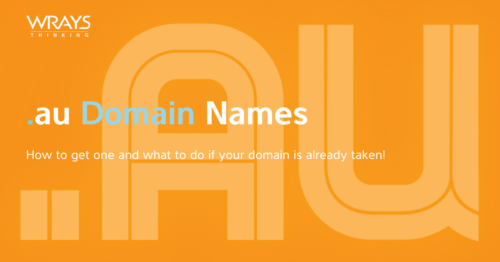How to get one and what to do if your domain is already taken!
Domain names
When choosing a new name for a business, the advice is generally “Don’t forget the trade mark and domain name!”. But which comes first? Ideally, they all come together. The business name is required for regulatory purposes, the trade mark is required for branding and generating goodwill, and the domain name gives the business its online presence.
There’s a lot written about business names and trade marks, so this time we thought we’d take a closer look at domain names in the .au space.
Since 1986, businesses have been able to register domain names ending with .au but they had to be what are called “second level domain names”. For commercial entities, this meant being paired with .com or .net, for example, <bestbusiness.com.au>.
On 24 March 2022, .au became available as a direct domain namespace. This means being able to register <bestbusiness.au>.
Requirements for a .com.au, .net.au or .au domain name licence
Note, when you “buy” a domain name, what you are really getting is a licence to use that domain name. The body that governs the requirements for .au domain names is a not-for-profit organization known as auDA. To get any type of .au domain, the person applying for the licence must have an Australian connection. The easiest way to establish an Australian connection is to have an Australian registered trade mark and apply for a domain name that is an exact match to the words in the trade mark.
There are then other requirements depending on the type of domain licence wanted. For the popular .com.au and .net.au domain names, the requirements essentially relate to establishing a nexus between the domain name and the person wanting the domain name or their goods or services. In relation to the .au direct space, the only requirement is the Australian connection requirement.
Help – someone got my domain name first!
It seems so unscrupulous. A business wants to register a domain name which includes its trade mark, only to find someone else has registered it first. The business approaches the holder of the domain name and is told the owner will transfer it but at a price. To the frustration of trade mark owner, if a person complies with the above eligibility criteria, then they can acquire a .com.au or .net.au purely for the purpose of reselling it.
But it’s not all doom and gloom for trade mark owners. auDA’s dispute resolution policy (auDRP) is an alternative to going to court for resolving disputes concerning domain names. Provided the person claiming rights in the domain name meets the eligibility requirements and can prove the following three matters, auDA can make a decision to have the disputed domain name transferred:
- the domain name is identical or confusingly similar to a name, trade mark or service mark in which the complainant has rights; and
- the respondent, that is the current holder of the domain name, has no rights or legitimate interests in respect of the domain name; and
- the domain name has been registered or subsequently used in bad faith.
There are fees for lodging a complaint and, unlike in court proceedings, these fees or any legal costs are not recoverable. However: the overall costs of the auDRP process are significantly cheaper than engaging in court proceedings; a typical case under the auDRP will reach a concluded decision within around 8 weeks; if successful, the auDRP panel member will order the Registrar to transfer the disputed domain name to the complainant without any further need or involvement to enforce the decision against the prior registrant.
There are also some instances where a person might be able to complain to the Registrar, that is the entity responsible for licensing the domain name and ask that the domain name licence be cancelled.
Reasons for applying to the Registrar for cancellation of a licence include that the owner is not eligible to hold the licence, the licence is being used to facilitate conduct which is unlawful or fraudulent under Australian law, or it is not in the public interest. If a complainant is not satisfied with the Registrar’s decision, the matter can be escalated to auDA.
Ending up in a dispute is never the best option for business owners. Securing the rights to relevant domain names should be one of the priorities of a business choosing a name and may be a practical pre-consideration when assessing the availability of a new name and trade mark for use.
If you need assistance selecting or registering your domain name or trade mark, our team can assist.

